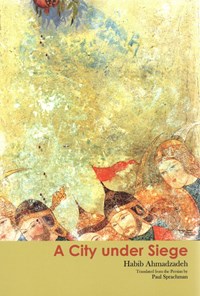
کتاب A city under ciege
معرفی کتاب A city under ciege
Tales of the Iran-Iraq War؛ A city under ciege ترجمه کتاب داستانهای شهر جنگی نوشته حبیب احمدزاده است.
این کتاب شامل شش داستان با موضوع جنگ ایران و عراق است که از روی آنها چند فیلم سینمایی نیز ساخته شده است.
پرعقاب، هواپیما، چتری برای کارگردان، سی و نه و یک اسیر، نامهای به خانواده سعد، اگر دریاقلی نبود، نام داستانهای این مجموعهاند.
در انتهای کتاب نیز متن نامه حبیب احمدزاده به نظامیهای امریکایی ناو وینست آمده است که در حمله به هواپیمای ایرباس ایرانی ۲۹۰ سرنشین آن را به شهادت رساندند .سپس جوابیه آنها نیز آمده است.
داستانهای این کتاب واقعگرایانه و با دو زاویه دید روایت شدهاند. یکی دوم شخص مفرد و دیگری اول شخص که گاهی هم به تک گویی نمایشی نزدیک میشوند.
A City under Siege (Dastanha-ye Shahr-e Jangi) is the second workby Habib Ahmadzadeh to appear in English translation. The first was a novel called Chess with the Doomsday Machine (Costa Mesa, CA: Mazda, 2008). Like the novel, the present collection draws on the author’s experiences as a Basiji (paramilitary volunteer) during the Iran-Iraq War (1980-88). The city under siege in the title is Abadan, which is located on an island near the northeastern end of the Persian Gulf. During the initial stages of the Iran-Iraq war, the fighting in and around Abadan and its sister city, Khorramshahr, was so intense that the Iranians renamed the latter “Khooneenshahr” or “Blood City.” Iraqi forces eventually took Khorramshahr, but despite laying siege to Abadan for the good part of a year, and after bombarding it with countless projectiles, they never managed to capture the city.
Abadan was an important Iraqi military objective for two reasons. First, because of its position along the Shatt al-Arab, the waterway separating the warring states, capturing the city was vital to Saddam’s ambition to control the entire—in his words—“Arabian Gulf.” Second, at the time of the Iraqi invasion (September 1980), Abadan was the site of the largest petrochemical complex in the world; by taking the complex, Saddam would have effectively doubled Iraq’s refining capacity. Nevertheless, after failing to capture the city, Iraqi forces bombarded the complex, setting off one of the brightest conflagrations of the War. The smoldering ruins of the main refinery serve as a constant reminder of the Iraqi shelling in Chess with the Doomsday Machine and in several of the stories translated here.
The nine stories in the translation are: “Eagle Feather,” “The Airplane,” “An Umbrella for the Director,” “Thirty-nine plus One Prisoners,” “The Fleeing of the Warrior,” “A Letter to the Family Saad,” “If there were no Darya Qoli,” “Vengeance, Vengeance, Vengeance,” and “Neneh.” The last two stories were added to the original seven to make what would have been a very slim volume slightly plumper. The Persian edition used here is the sixteenth (Tehran: Sureh-ye Mehr, 2008), and contains some 190 pages, including materials on an incident that occurred at the end of the War. On 3 July 1988, the Vincennes, a US navy missile cruiser, shot down an Iranian airliner killing all 290 passengers and crew members on board. Other than illustrating the senseless loss of civilian life during war, the Vincennes Incident has little to do with the stories in the collection, almost all of which take place at the outset of the conflict and are narrated by Iranian soldiers.
حجم
۷۸۱٫۸ کیلوبایت
سال انتشار
۱۳۹۰
تعداد صفحهها
۱۱۲ صفحه
حجم
۷۸۱٫۸ کیلوبایت
سال انتشار
۱۳۹۰
تعداد صفحهها
۱۱۲ صفحه